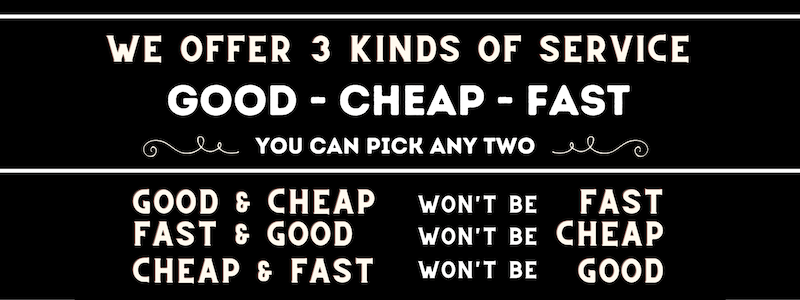When I think about trade-offs, the proprietors of a print shop come to mind. When we first met, they had just moved from a small print shop into a massive new facility in response to the increasing demand for their services. Like many small companies, this business had a back story; the owners had experienced some crushing setbacks that had forced them to close a previous business and start over.
Not afraid of hard work and long hours, the owners’ second attempt in the printing business became a rousing success. Their graphic design capabilities and their commitment to customer service resulted in loyal customers who consistently chose them over their competitors. Perhaps one key to their success was educating customers about trade-offs, in this case with a large sign hanging prominently in their lobby: “Fast. Cheap. Good. Pick any two.”
Economist Thomas Sowell said, “There are no solutions; there are only trade-offs.” More of one thing will always necessitate less of another. An airline can choose to serve meals—adding cost and slowing turnaround time at the gate—or it can choose not to. The airline cannot offer meals without incurring additional costs and inefficiencies; but many of the airline’s customers would gladly accept a little more time between flights in exchange for the “luxury” of being offered a sandwich.
Business leaders are faced with ever more vocal needs and wants of customers, shareholders, governmental regulators, and other groups of stakeholders. While attempting to meet the different interests and needs of various stakeholders – which are rarely aligned — leaders are often forced into making trade-offs as they develop strategies for the organization.
What are you willing to be average at in order to be amazing?
With limited resources, it is not difficult for leaders to recognize the need for trade-offs. This starts with knowing how the right trade-offs can improve the organization’s position in the marketplace. The following considerations will help to ensure your organization is making the right trade-offs:
Know your trade-offs. What are the current organizational choices and what trade-offs have already been made? What trade-offs have led to your customers’ perceptions of your products? In the auto industry, for example, BMW has a reputation for the driving experience and Volvo has a reputation for safety. Analyze your business model with an eye to understanding the trade-offs implicit in your organization’s choices. Evaluate which aspects of your organization are winning and which are losing in the status quo.
As Ryerson University researchers noted in “Supply Chain Management Review,” the pandemic has shaken global supply chains to the core and tested the ability of companies to keep up with surging demand for some products. To survive, many companies have looked for new suppliers when export restrictions or facility shutdowns have threatened inventory levels. But while having a wider or redundant supplier base can facilitate such pivots, it also brings trade-offs related to increased costs or reduced efficiency.
Communicate your trade-offs. Clear communication of trade-offs will allow everyone to know where the organization intends to focus and how it intends to win. People within your organization may naturally fight back on change, particularly if competing financial incentives pit various business units within the company against one another (for example, one group may be incentivized for product design, another incentivized for product reliability, and a third group for sales). When an organization has a well-communicated strategy that requires significant trade-offs in the best interest of the business, employee incentives are aligned toward work activities that create market growth for the company.
Innovate around trade-offs. Companies can get out of the business-case trap of the status quo through innovation. Rather than considering previously made trade-offs as “permanent,” companies can innovate new ways to deliver value.
A decade and a half ago, environmentalists advocated for Walmart to switch its product line from standard incandescent lightbulbs to more energy-efficient compact fluorescent lightbulbs. Walmart then leaned on General Electric and other suppliers. General Electric initially hesitated to give up the prime shelf space it had acquired for its incandescent lightbulb, its best-selling product. To meet Walmart’s demands, General Electric’s leaders soon decided to get in front of the change with innovation; and this ultimately led to other new lightbulb technologies superior to the compact fluorescent lightbulbs that consumers had originally wanted.
Many trade-offs are noticeably uncomfortable or even painful for the organization and its customers. However, these tough trade-offs are necessary from a marketplace perspective and are key for growth. Trade-offs help identify the most strategic areas and allow an organization to put its resources where they will have the biggest impact.
A McKinsey article (“From Surviving to Thriving”) noted that the pandemic and its aftermath have forced many companies to make the trade-offs associated with integrating business processes, incorporating data-driven decision making, and/or implementing change management. Making the necessary trade-offs and aligning business priorities (for example, creating new or improved digital practices) has enabled a wide variety of companies to accelerate delivery of their products or services.
Differentiation by design® comes at a cost, and it starts by paying attention to patterns in what your customers value. Rigorously making and adhering to the right tradeoffs can focus resources, simplify an organization, communicate a strategic direction to employees, and ultimately drive differentiation and growth in the marketplace. By making the right trade-offs, your business will be able to focus on improving your offering for most of your customers, most of the time.





